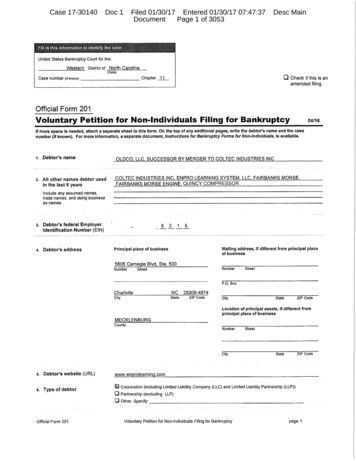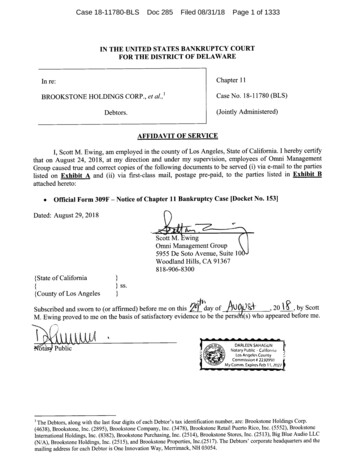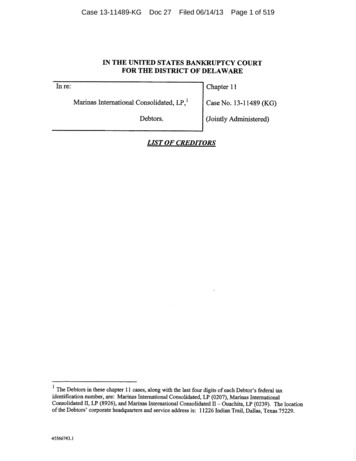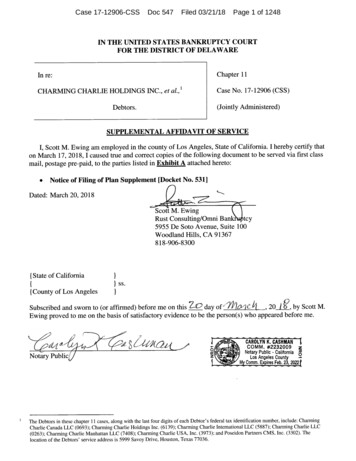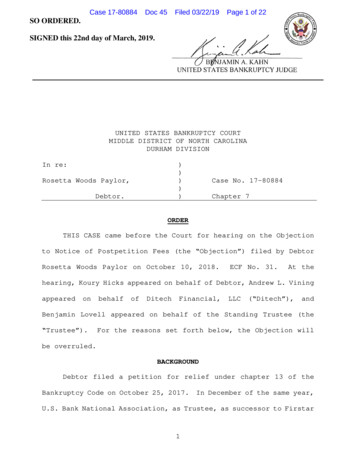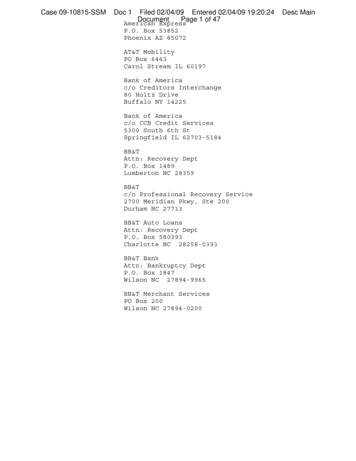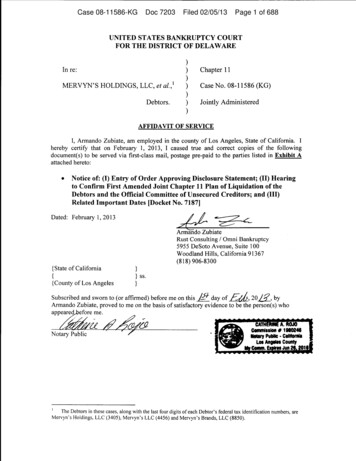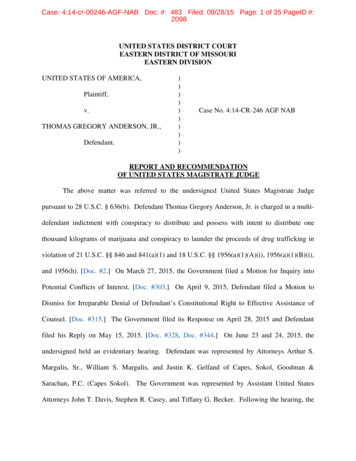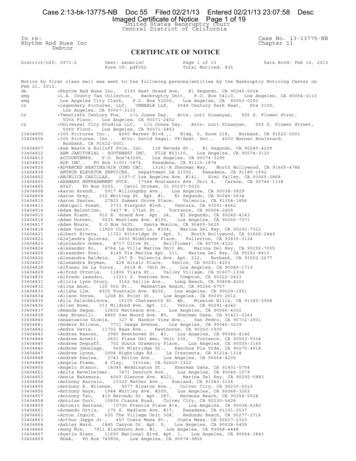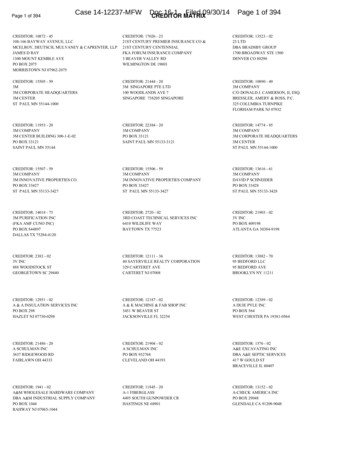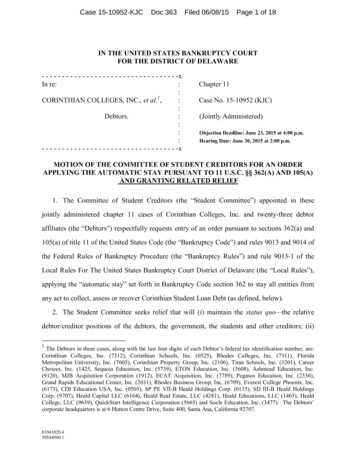
Transcription
Case 15-10952-KJCDoc 363Filed 06/08/15Page 1 of 18IN THE UNITED STATES BANKRUPTCY COURTFOR THE DISTRICT OF DELAWARE- - - - - - - - - - - - - - - - - - - - - - - - - - - - - - - - - -xIn re:::CORINTHIAN COLLEGES, INC., et al.1,::Debtors.::::- - - - - - - - - - - - - - - - - - - - - - - - - - - - - - - - - -xChapter 11Case No. 15-10952 (KJC)(Jointly Administered)Objection Deadline: June 23, 2015 at 4:00 p.m.Hearing Date: June 30, 2015 at 2:00 p.m.MOTION OF THE COMMITTEE OF STUDENT CREDITORS FOR AN ORDERAPPLYING THE AUTOMATIC STAY PURSUANT TO 11 U.S.C. §§ 362(A) AND 105(A)AND GRANTING RELATED RELIEF1. The Committee of Student Creditors (the “Student Committee”) appointed in thesejointly administered chapter 11 cases of Corinthian Colleges, Inc. and twenty-three debtoraffiliates (the “Debtors”) respectfully requests entry of an order pursuant to sections 362(a) and105(a) of title 11 of the United States Code (the “Bankruptcy Code”) and rules 9013 and 9014 ofthe Federal Rules of Bankruptcy Procedure (the “Bankruptcy Rules”) and rule 9013-1 of theLocal Rules For The United States Bankruptcy Court District of Delaware (the “Local Rules”),applying the “automatic stay” set forth in Bankruptcy Code section 362 to stay all entities fromany act to collect, assess or recover Corinthian Student Loan Debt (as defined, below).2. The Student Committee seeks relief that will (i) maintain the status quo—the relativedebtor/creditor positions of the debtors, the government, the students and other creditors; (ii)1The Debtors in these cases, along with the last four digits of each Debtor’s federal tax identification number, are:Corinthian Colleges, Inc. (7312), Corinthian Schools, Inc. (0525), Rhodes Colleges, Inc. (7311), FloridaMetropolitan University, Inc. (7605), Corinthian Property Group, Inc. (2106), Titan Schools, Inc. (3201), CareerChoices, Inc. (1425, Sequoia Education, Inc. (5739), ETON Education, Inc. (3608), Ashmead Education, Inc.(9120), MJB Acquisition Corporation (1912), ECAT Acquisition, Inc. (7789), Pegasus Education, Inc. (2336),Grand Rapids Educational Center, Inc. (2031), Rhodes Business Group, Inc. (6709), Everest College Phoenix, Inc.(6173), CDI Education USA, Inc. (0505), SP PE VII-B Heald Holdings Corp. (0115), SD III-B Heald HoldingsCorp. (9707), Heald Capital LLC (6164), Heald Real Estate, LLC (4281), Heald Educations, LLC (1465), HealdCollege, LLC (9639), QuickStart Intelligence Corporation (5665) and Socle Education, Inc. (3477). The Debtors’corporate headquarters is at 6 Hutton Centre Drive, Suite 400, Santa Ana, California 92707.61041020.450544980.1
Case 15-10952-KJCDoc 363Filed 06/08/15Page 2 of 18preserve the integrity of the chapter 11 process; and (iii) avoid a multiplicity of litigation invarious forums that will waste resources that would be better utilized in addressing creditorneeds and claims. 2 The Debtors received billions of dollars from government and private“student loan” programs for educational programs, the efficacy and value of which weresignificantly misrepresented to the students, the government and accreditation agencies.Undeniably, in these chapter 11 cases, the Debtors’ estates will be subject to claims to return anyfunds that were wrongfully received and the students will seek, among other things, thecancellation of alleged “student loan” obligations—obligations that rightfully should be chargedto the Debtors’ estates. The Debtors’ estates cannot be efficiently administered until the breadthof the Debtors’ misconduct and the nature and amount of the claims against the Debtors’ estatesare determined. Concentrating and resolving these issues through the bankruptcy process is themost efficient path, in the best interest of the parties and is the central purpose of the Motion.3. In support of this Motion, the Student Committee relies upon and incorporates byreference the Declaration of Cynthia C. Hernandez (“Hernandez Declaration”); the Declarationsof Tasha Courtright, Amber Thompson, Brittany Ann Smith Jackl, Jessica King, Crystal Loeserand Michael Adorno-Miranda (the “Student Declarations”); and the Request for Judicial Notice(“RJN”), filed concurrently with this Motion. In further support of the Motion, the StudentCommittee, by and through its undersigned counsel, respectfully represents as follows:JURISDICTION & VENUE4. This Court has jurisdiction to consider this Motion under 28 U.S.C. §§ 157 and 1334 andvenue is proper under 28 U.S.C. §§ 1408 and 1409. This is a core proceeding under 28 U.S.C. §157(b)(2). The statutory bases for the relief requested herein are Bankruptcy Code sections 105and 362.2While the United States Department of Education (“DOE”) has recently announced a partial voluntary forbearance,such action does not obviate the need for the relief sought in the Motion for numerous reasons: first, the forbearanceis not on a class-wide basis, and will require individual students to seek such relief; second, the relief will only beeffective for twelve months; third, interest will continue to accrue during the period of forbearance; fourth, it affectsonly federal loans; and, finally, the voluntary nature of this relief means that the DOE can revise the forbearance atany time.-261041020.450544980.1
Case 15-10952-KJCDoc 363Filed 06/08/15Page 3 of 18PROCEDURAL BACKGROUND5. On May 4, 2015 (the “Petition Date”), the Debtors filed voluntary petitions for reliefunder chapter 11 of the Bankruptcy Code. The Debtors are operating as debtors in possessionpursuant to Bankruptcy Code sections 1107 and 1108.6. On May 15, 2015, the United States Trustee appointed the Student Committee 3 torepresent the interests, and act on behalf, of all student creditors of the Debtors.RELIEF REQUESTED7. By this Motion, the Student Committee requests entry of an Order, substantially in theform attached hereto as Exhibit A, applying the “automatic stay” afforded under BankruptcyCode section 362(a) to operate as a stay, applicable to all entities, of any act to collect, assess orrecover a claim or debt which relates to funds provided pursuant to (i) Title IV of the HigherEducation Act of 1965, as amended, 20 U.S.C. §§ 1070 et seq. (a “Federal Student Loan”);4 or(ii) the Genesis, EducationPlus or other private student loan programs (a “Private StudentLoan”)5 for the purpose of paying the expenses necessary for students to attend the Debtors’colleges; expenses may include students’ tuition, fees, room and board, books, supplies,equipment, dependent child care expenses, transportation, commuting expenses, personalcomputer, and loan fees (the aggregate of the obligations outstanding as of the date hereof ishereinafter referred to as the “Corinthian Student Loan Debt”).3The members of the Student Committee are: Tasha Courtright, Jessica King, Amber Thompson, Crystal Loeser,Michael Adorno-Miranda, Krystle Powell and Brittany Ann Smith Jackl.4See infra ¶¶ 23-30.5See infra ¶¶ 31-36.-361041020.450544980.1
Case 15-10952-KJCDoc 363Filed 06/08/15Page 4 of 18BASIS FOR REQUESTED RELIEFI.FACTS SPECIFIC TO THE REQUESTED RELIEFA.The Debtors’ Operations8. The Debtors were founded in February 1995 and became one of the largest for-profitpost-secondary education companies in the United States and Canada. [Debtors’ First Day Decl.,¶ 8, Dkt. No. 10].9. As of March 31, 2014, the Debtors operated over 100 campuses and had currentenrollment in excess of 74,000 students with more than 10,000 employees. [Id.]10. At its many campuses, the Debtors’ colleges - Heald, Everest and Wyotech—offeredprograms in many fields, including health care, business, criminal justice, transportationtechnology and maintenance, construction trades and information technology. [Id.]11. The Debtors’ nationwide enrollment grew from 28,372 students in 2001 to a peak of113,818 students in 2010. In 2011, enrollment declined to approximately 94,000 and, thereafter,continued to experience moderate decline through the closure of its remaining schools in April,2015. [RJN Exh. A, p. 409.]12. The cost of education at the Debtors’ schools was much higher than similar not-for-profitschools and the Debtors “lack[ed] transparency regarding these costs.” [Id. at p. 415-16.] Forexample, a Medical Assistant Diploma Program at the Debtor’s Heald College in Fresno,California was 22,275.15, compared to 1,650 at a local community college (Fresno CityCollege). [Id.] An associate degree in paralegal studies at Debtors’ Everest College in Ontario,California, was 41,149, compared to 2,392 for the same degree at a local community college(Santa Ana College). The Debtors charged 82,280 for a Bachelor’s Degree in Business,compared to 55,880 at the University of California – Irvine. [Id. at 415.]13. In general, the cost of education for an 8-12 month diploma program ranged from 13,100- 21,338; associate’s degree (24 months) ranged from 33,120- 42,820; and abachelor’s degree ranged from 60,096- 75,384. [RJN Exh. B at ¶ 32.]-461041020.450544980.1
Case 15-10952-KJCB.Doc 363Filed 06/08/15Page 5 of 18The Debtors’ Continued Misconduct14. The Debtors consistently misled prospective and current students, the government andaccreditation agencies about the value and successes of the Debtors’ programs. Based on theDebtors’ misrepresentations, students enrolled in Debtors’ educational programs at inflated ratesthat allowed Debtors to take billions of taxpayers’ dollars from federally-funded student loanprograms, the repayment of which is currently being sought from students. See generally, theStudent Declarations.15. In 2007, the Debtors were fined and thereafter permanently enjoined from, among otherthings, engaging in misleading practices related to the recruitment of students and pressuringprospective students to sign documents before reasonable review. [See RJN Exh. G at p. 14.]16. However, even after 2007, the Debtors consistently misrepresented job placement ratesand starting salaries for graduates of their educational programs. Prior to the Petition Date,litigation related to the Debtors’ deception and misrepresentations was expanding rapidly.Attached to the concurrently filed Hernandez Declaration as Exhibit A is a chart detailing someof the myriad of lawsuits now pending against the Debtors stemming from allegations of theirmisconduct. [See generally, RJN Exh. B through F.]17. In April, 2015, the DOE levied a 30 million fine against the Debtors after acomprehensive investigation which found that the Debtors “failed to meet the fiduciary standardof conduct by misrepresenting its [job] placement rates to current and prospective students and toits accreditors, and by failing to comply with federal regulations requiring the complete andaccurate disclosure of its placement rates.” [RJN Exh. H at 1.]18. The DOE found that the Debtors intentionally misled students and accreditationagencies. For example, the DOE’s investigation found that in 2011 the Debtors reported that thecampus job placement rate for students in its Medical Office Administration program (AADegree) at Heald’s Hayward and Modesto campuses was 100%; in reality, the placement ratewas 38% according to the Debtors’ own data. [Id. at Enclosure A.] In all, the DOE investigation-561041020.450544980.1
Case 15-10952-KJCDoc 363Filed 06/08/15Page 6 of 18uncovered no less than 947 specific instances in which the Debtors had misstated job placementrates.19. Immediately prior to the Petition Date, the DOE notified the Debtors that their pendingapplications to continue participating in programs under Title IV of the Higher Education Act, 20U.S.C. §§ 1001 et seq. (“Title IV FSA Programs”) at Heald’s Salinas and Stockton collegeswould be denied. [Id.]C.Student Claims For Relief For The Debtors’ Misconduct20. The Student Committee will, among other things, pursue relief in these cases for studentsthat were misled regarding the value and nature of the Debtors’ programs. For example, theStudent Committee will seek a determination or an agreement among the Debtors and thegovernment that students will not be held responsible for the funds advanced to the Debtors forprogram enrollments that were based on the Debtors’ misrepresentations.21. Through the collective proceeding and a consensual plan, the Student Committee willseek to relieve the Court, the government, the Debtors and students from individual proceedingsby all former students that are aggrieved by the Debtors’ misconduct.D.Student Loan Funding22. “As proprietary post-secondary institutions, the Debtors rel[ied] on funding from theDepartment of Education, pursuant to [Title IV FSA Programs]. Title IV funds accounted fornearly 90% of the Debtors’ revenue prior to the Petition Date.” [Debtors’ First Day Decl., ¶ 14,Dkt. No. 10 (emphasis added)]. Presumably, the remaining 10% of the Debtors’ revenue camefrom students’ funding, use of students’ GI Bill benefits and from Corinthian Private StudentLoan Programs (as defined below).1.Federal Student Loans23. The United States was the primary funding source for the Debtors’ operations throughfederal student aid programs administered by the DOE under Title IV FSA Programs.24. To qualify for participation in Title IV FSA Programs, for-profit and postsecondaryvocational institutions, like the Debtors, must, among other requirements: (1) be authorized by-661041020.450544980.1
Case 15-10952-KJCDoc 363Filed 06/08/15Page 7 of 18the state in which the institution is operating, (2) be accredited by a federally recognized agency,(3) enroll only students who hold a high school diploma or recognized equivalent and are beyondthe compulsory school age, (4) derive at least 10% of their school revenue from non-Title IVfunds (the “90/10 Rule”), and (5) comply with certain refund policy requirements. [RJN Exh. I at2.]25. The DOE also sets additional requirements for postsecondary institutions by settingfederal standards that accrediting agencies must meet to achieve federal recognition. 34 CFR§§602.16-602.21. These standards focus on ensuring that the institutions being accredited meetacceptable levels of educational quality. See, e.g., 34 CFR § 602.16(a)(1) (“The agency’saccreditation standards effectively address the quality of the institution or program in thefollowing areas: (i) success with respect to student achievement in relation to the institution’smission (ii) curricula, (iii) faculty . . . .”).26. Prior to July 2010, Title IV FSA Programs were administered through: (1) the WilliamD. Ford Federal Direct Loan Program (20 U.S.C. §§ 1087a–1087j); (2) the Perkins LoanProgram (20 U.S.C. §§ 1087aa–1087ii); or (3) the Federal Family Education Loan Program(“FFEL”) (20 U.S.C. §§ 1071–1087-4).27. Funds provided under the William D. Ford Federal Direct Loan Program (“DirectLoans”) were “made by participating institutions [i.e. schools], or consortia thereof, that haveagreements with the Secretary [of Education] to originate loans, or by alternative originatorsdesignated by the Secretary [of Education] to make loans . . . .” 20 U.S.C. § 1087a.28. The FFEL Program allowed private entities to make loans to students which are insuredor guaranteed by the federal government. See 20 U.S.C. § 1071(b). If students default on theseloans, the private lender is repaid by the guaranty agency. See 20 U.S.C. § 1085(a) & (d); 34C.F.R. § 682.411, 682.507.-761041020.450544980.1
Case 15-10952-KJCDoc 363Filed 06/08/15Page 8 of 1829. As of July 2010, the FFEL and Federal Loan Insurance6 programs were terminated and,thereafter, federal student aid funding has been made exclusively through the William D. FordFederal Direct Loan Program. See 20 U.S.C. §§ 1087a et seq. Funding under these programs ismade directly by the DOE. Id. at § 1087b(a).30. Based on the Debtors’ reported tuition and enrollment statistics, as well as the Debtors’reported percentage of revenues derived from Title IV FSA Programs, in recent years, theDebtors may have received in excess of 1 billion of revenue each year through funds suppliedby Title IV FSA Programs.2.Private Student Loans31. To insure compliance with the 90/10 Rule, the Debtors intentionally set tuition rates atan amount that was 10% higher than the amounts available under Title IV FSA Programs andprovided students with options for obtaining privately-funded loans (“Corinthian Private LoanPrograms”) (the aggregate of all of the Debtors’ students’ outstanding obligations related to theCorinthian Private Loan Programs is hereinafter referred to as the “Corinthian Private StudentLoan Debt”). [RJN Exh. A, p. 431.]32. The two loan programs instituted by the Debtors are known as the Genesis Program andthe EducationPlus Loan Program.33. The Consumer Finance Protection Bureau determined that the Genesis program was athinly-veiled form of “institutional lending” program, meaning that the Debtors were, in essence,lending funds directly to the students. Because direct institutional lending does not fully counttoward the 10% requirement for non-federal funds that a for-profit school must take in to remaineligible for Title IV FSA Programs, the Debtors devised a complex arrangement with a thirdparty where the school would guarantee or promise to buy back non-performing loans made bythe third party. [See RJN, Ex. B at ¶ 89-93.] In essence, the third-party lender was little morethan the Debtors’ conduit or agent to make these loans to students.620 U.S.C. § 1074 (Scope and duration of Federal loan insurance program defining the limitations on the amountsof loans covered by federal insurance and apportionment of amounts.)-861041020.450544980.1
Case 15-10952-KJCDoc 363Filed 06/08/15Page 9 of 1834. Similarly, under the EducationPlus Loan Program, in 2011, the Debtors entered into anew type of financial agreement with two separate financial entities to provide private loans toCorinthian students. Under this scheme, the first lender paid funds directly to the Debtors, whichapplied the funds toward students’ tuition. Concurrently, a second institution purchased thealleged “student-loan” from the first lender and the Debtors paid the second institution a largeupfront fee equal to 50% of the funds advanced. The second institution then had the right to forcethe Debtors to purchase the alleged loan at face value, less the fee already paid, if the loanbecame more than 90 days past due. [See RJN, Ex. F at ¶74.]35. Between July 2011 and March 2014, the Debtor induced nearly 130,000 students to takeGenesis Loans and EducationPlus Loans, with the aggregate amounts outstanding on these loansestimated to be in excess of 568.7 million. [See RJN, Ex. B at ¶ 103.] These loans weremarketed, promoted, and offered to students by the Debtors and for the Debtors’ benefit. [Id. at ¶107.]36. The Debtors also engaged in improper debt collection practices on these loans, includingpulling students out of class and barring students from attending classes and externships untilpayments were made. [See RJN, Ex. F at ¶ 77.]II.LEGAL BASIS FOR THE REQUESTED RELIEFA.Introduction37. The automatic stay must be applied or extended, as necessary, to maintain the status quoand promote an efficient resolution of issues related to the Debtors’ obligations with respect toCorinthian Student Loan Debt. Among other claims, the Debtors are responsible for therepayment of billions of dollars, charged against students as alleged “student loan debt,” that theDebtors have received through misrepresentations and deception. While a final accounting andresolution of such claims is sought in these cases, the students must be relieved of the harassmentand undue hardships caused by the continuing collection proceedings related to these obligations.38. As opposed to individual litigation with each student, negotiations by the class ofaggrieved students to achieve a consensual plan among the Debtors, students, the government-961041020.450544980.1
Case 15-10952-KJCDoc 363Filed 06/08/15Page 10 of 18and other creditors is the most efficient path to resolve the Debtors’ and student
example, a Medical Assistant Diploma Program at the Debtor s Heald College in Fresno, California was 22,275.15, compared to 1,650 at a local community college (Fresno City College). [ Id .] An associate degree in paralegal studies at Debtors Everest College in Ontario,

